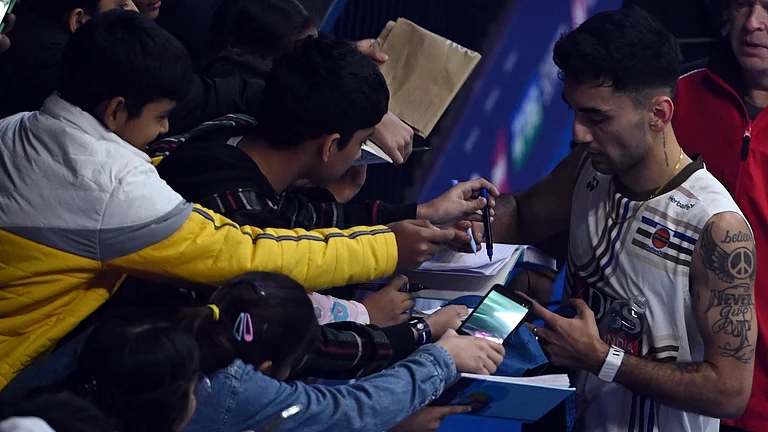In a week when statues, from the north to south, came under protective cover, a flag was unfurled in Karnataka—the banner, in a manner of speaking, to hold Chief Minister Siddaramaiah’s politics aloft, as the battle lines in the assembly elections get sharper. Its evocative symbolism and its timing—at least for the state’s ruling Congress—couldn’t have been better.
These days, every event in this southern state is sucked inevitably into the poll swirl—the arrest of a Hindu Yuva Sena activist in connection with the murder of journalist Gauri Lankesh caused the BJP enough discomfiture to elicit loud protests. Then, a murderous attack on the Karnataka Lokayukta by a complainant inside his office in Bangalore handed it ample ammunition to attack Siddaramaiah on the state’s law and order situation. But by unveiling a design of Karnataka’s new state flag on March 8, it’s clear that the CM, a veteran of the politics around Kannada pride, is weaving a regional counter-narrative to take the edge off the BJP’s Hindutva card and its largely Delhi-led campaign. A chauvinism-for-chauvinism approach, so to say.
“Siddaramaiah has realised that he can turn the battle against the BJP in his favour by focussing on the local. The flag issue is linked to a range of other issues,” says political analyst Sandeep Shastri. Caste coalitions, to start with. The Karnataka CM has long been accused of being castiest, but has claimed social justice as the central plank of his politics around AHINDA (an acronym in Kannada for minorities, backward classes and Dalits). Invoking Kannada swabhimana (self-esteem), as a response to the BJP’s narrative of one-nation and national agenda UNIfying behind one leader, accompanies the larger social coalition he’s trying to stitch up with the promise of Lingayat religious minority status. On both accounts, critics say he’s sailing close to the wind. Playing with sensitive issues like identity pride, they say, might spiral out of control.
Language assertion, at least, isn’t new and nowhere more evident than in the capital city, occasionally stirring up overt chauvinism, especially whenever a Cauvery wave rose up. Now, it’s the Centre’s Hindi imposition, as the ruling Congress calls it—the visible example being Hindi signages in the Bangalore Metro stations removed by the government, Siddaramaiah’s point to the Centre being that it would be better to follow a persuasive approach than a mandatory one. Then there is displeasure about bank recruitment policies that disregard Kannada and are hence disadvantageous to locals.
The Congress advertised the fact that its choice of three candidates for the upcoming Rajya Sabha elections didn’t feature any ‘outsiders’, as national parties often do—it nominated writer L. Hanumanthaiah, G.C. Chandrashekhar and AICC spokesman Syed Nasir Hussain, all three ‘staunch Kannadigas’, as Congress leader Dinesh Gundu Rao put it.
“Siddaramaiah has done good work in terms of the economy, giving subsidies to poor people.... But he’s trying to play the wrong card with the Tipu Sultan Jayanti and appealing to the Kannada emotion,” says former Infosys board member T.V. Mohandas Pai. “The average Kannadiga is fairly educated, is very moderate and very liberal. There are some groups who try to be more Kannadiga but that has not won elections in the past,” he says. Apart from Bangalore, point out others, there’s not much of a Kannada surge elsewhere, except maybe Belgaum district.
Says Prof S.G. Siddaramaiah, chairman of the Kannada Development Authority: “Any cosmopolitan city, even when it welcomes every culture, will not forsake its very essence, nor should it. Kannada is the ‘asmita’ of this land, just as being all-inclusive is the ‘asmita’ of our federal set-up. Karnataka is committed to both,” he says. The state, he says, has never taken an adversarial position when it came to other languages, pointing at Konkani, Tulu, Kodava, Arebhashe, Beary and Urdu. “Each has academies and there’s no discrimination when it comes to funding.”
More significantly, by unveiling a new state flag, CM Siddaramaiah has only put the Centre in the delicate position of having to decide if a state can have its own flag.
“He’s attempting to wrest the initiative from the BJP, rather than allowing it to set the agenda,” says Shastri. Of course, the BJP, too, isn’t letting up and wants to bring the focus back onto familiar ground, through fiery Hindutva campaigners like Uttar Pradesh CM Yogi Adityanath and Union minister Ananth Kumar Hegde. “It’s basically a challenge between two alternative narratives,” says Shastri.
But the BJP can’t disown flag politics entirely, having once trodden down that path. Nor can it forgo local sentiment too, and so we now have train tickets printed in Kannada too.
In 2012, when the BJP was in power, then chief minister D.V. Sadananda Gowda decreed that the Kannada flag would be compulsorily hoisted on state formation day (November 1) every year in government offices, schools and colleges. It turned out that a political party, Kannada Paksha, held the rights to the red-yellow flag, and the government withdrew the order when the matter went to court.
“Now, this government has resolved all the questions that the court had raised then,” says Prof Siddaramaiah. The government has essentially approved a new design—a tricolour which has a white band (representing peace and stability) running between the yellow (wealth and celebration) and red (valour and pride) with Karnataka’s state emblem, the Gandaberunda, in the middle. The Gandaberunda, a mythical two-headed bird flanked by the Sharaba—a lion with the head of an elephant—was the royal insignia of the Mysore Wodeyars.

Rajkumar at a Gokak rally
“Nowhere does it say you cannot have a flag, nor does it say anywhere that you can. So there are no hurdles legally,” Prof. Siddaramaiah tells Outlook. “This is not an alternative to our national flag. The national flag will always fly higher.”
Some history would help to decode the events. Later this month, the Kannada Sahitya Parishat will commemorate the birth centenary of Ma. Ramamurthy, a Kannada writer who, in the mid-’60s, hoisted a yellow and red (the colours represent the auspicious turmeric and vermillion) flag in Bangalore during the incipient Kannada pride movement. “When the movement started, it was in reaction to the domination of Tamils in Bangalore,” says poet Chandrashekar Patil, who was part of the intelligentsia that began its next phase, in the early ’80s, to protest the state government’s move to make Sanskrit a compulsory language in schools. “All these decades, we have emotionally accepted this flag as an emblem of Kannada pride and pressing the state government to give it legal sanction,” he says.
The Kannada movement, Patil says, has also played a key role given the history of the unification of a state whose territories lay scattered in erstwhile presidencies and princely states in 1947. “Had there been no issues concerning the cause of Kannada, these different parts of Kannada Nadu would rather be away from each other, distrusting each other. The Kannada cause is a cementing factor,” says Patil. For that matter, the chief minister’s connection to language pride also travels back decades. The 1980s Kannada agitation, centred around the Gokak report, was many things at once—a linguistic and cultural assertion and a farmers’ agitation. The action that began in Dharwad in northern Karnataka became widespread once actor Rajkumar stepped in. In 1983, when the Janata party came to power, Siddaramaiah became the first chairman of the Kannada Bhasha Kavalu Samiti, a watchdog for Kannada which later became the Kannada Development Author-ity. Therefore, he has, as political analyst Narendar Pani puts it, “a kind of say with Kannada organisations that other CMs didn’t”.
The BJP claims that a regional issue is being used as a ploy that won’t work. “Some people are trying to use issues against the Centre, thinking that they are using it against Narendra Modi,” says Suresh Kumar, adding, “They (Congress) are making a mountain out of a mole-hill. But people have understood it.”
Clearly, a paradox afflicts both parties—the BJP’s local leadership in Karnataka, still burdened by its troubled term in office between 2008-2013 needs the persona of Narendra Modi to win acceptability. On the other side, the unenviable track record of the Congress’s central leadership in recent elections means they need to back Siddaramaiah, as they did in Punjab with Capt. Amarinder Singh.
But even as Siddaramaiah worked out a consensus with pro-Kannada groups over a redesign of the Kannada flag, not everybody was happy. Veteran Kannada activist Vatal Nagaraj, who leads the Kannada Okkoota (federation), struck a discordant note. “Why did the government have to show such haste? Elections are coming. What was the need for a flag right now?” he asks. “Even if the red-yellow Kannada belonged to a political party, the government could have solved it by placing a Karnataka map in the centre of the existing one,” says Nagraj.
Plucking a politically expedient, low-hanging fruit has led to the kind of exclusionism seen elsewhere, where struggles over linguistic identity have taken root. And Bangalore, with its own historical paradoxes, has been pitched headlong at its centre.
By Ajay Sukumaran in Bangalore


























